Silver Dollar – How Much Is It Worth?
“I found a silver dollar, can you tell me how much it’s worth?” Believe it or not, this is a very common phone call we receive at Golden Eagle. We’ll usually oblige and play a little bit of I Spy and receive answers such as:
- “It’s got an old, bald guy on one side.”
- “The lady has like, spikes coming out of her head.”
- “There’s a bird on the back.”
After identifying their coin we’ll direct that person to a local coin dealer or our website because there are many factors that contribute to the value of a coin and it’s nearly impossible to do it blind. If they want to sell their coin, most times they end up mailing it in to us and we assess the coin when it arrives.
What Kind Of Silver Dollar Do I Have?
If you have an older silver dollar, or if you come across one, the first thing you want to do is identify what type of coin it is. The easiest way to start is by breaking down the coin by its date. There are 3 main groups by time period:
- 1794-1873: This covers the early dollars such as the Flowing Hair Dollar, Bust Dollar, Gobrecht Dollar, Seated Liberty Dollar, and also the Trade Dollar (although the Trade Dollar was minted until 1885 it’s usually lumped in with these coins).
- 1878-1935: This is the meat and potatoes of the silver dollar era and also the most popular. This period comprises two coins, the Morgan Dollar (the most popular silver dollar – and arguably most popular U.S. coin) and the Peace Dollar.
- 1971-1976: This period covers strictly Eisenhower Dollars (known as “Ikes” amongst avid coin collectors). Only a handful of specific dates were made in 40% silver composition, the rest of the circulating Eisenhowers were composed of copper-nickel clad and contain no silver.
All values listed below are derived from the Red Book, the definitive guide for U.S. coins. Please keep in mind many factors are involved such as the date of the coin, mintmark, variations, grade, etc. For the sake of the value below we are applying a grading range from Almost Good to Mint State. For a detailed guide, view our previous blog post on coin grading.
Flowing Hair Dollar (1794-1795)
The Flowing Hair Dollar is one of the earliest dollars minted by the United States. While there are many varieties that can be found, it is very difficult to keep track of their details because all of these early dies were made individually. Because modern technology was not available, no two dies were the same and as such, strike variations occurred. Not only were the dies different, but the silver blanks that were used prior to being stamped were weighed by hand as well and if a die was overweight it was filed down (again by hand) to achieve the correct weight. Conversely, if a blank was too light, a silver plug was inserted in the center of the blank planchet before the coin was struck.
Value: $1,100 – $750,000
Draped Bust Dollar (1795-1804)
Very similar to the Flowing Hair Dollar, the Draped Bust Dollar has many variations when it comes to their uniformity (different thicknesses, off-center dies, etc.). There was also a design change in 1798 called the Heraldic Eagle Reverse where the eagle design was changed from an anemic-looking eagle (many in the industry call this bird sickly-looking) to a more patriotic eagle with a shield. Also, there is a very rare variation known as the 1804 Dollar.
Value: $825 – $108,000
Heraldic Eagle Reverse Bust Dollar (1798-1804)
Value: $900 – $450,000
Note: there are more expensive Heraldic Eagle Reverse Draped Bust Dollar coins, most notably 2 that are dated 1801 Proof Restrike dollars (reverse struck from first die of 1804 dollar) that are valued at $1,000,000.
1804 Dollars
“The 1804 dollar is one of the most publicized rarities in the entire series of United State coins. There are specimens known as originals (first reverse), of which eight are known; and restrikes (second reverse), of which seven are known, one of which has a plain edge.
Numismatists have found that the 1804 original dollars were first struck at the Mint in the 1834 through 1835 period, for use in presentation Proof sets. The first coin to be owned by a collector, a Proof, was obtained from a Mint officer by Matthew Stickney on May 9, 1843, in exchange for an Immune Comumbia piece in gold. Later, beginning in 1859, the pieces known as restrikes and electrotypes were made at the Mint to supply the needs of collectors who wanted examples of these dollars.
Evidence that these pieces were struck during the later period is based on the fact that the 1804 dollars differ from issues of 1803 or earlier and conform more closely to those struck after 1836, their edges or borders having beaded segments and raised rims, not elongated denticles such as are found on the earlier dates.
Although the Mint record states that 19,570 dollars were coined in 1804, in no place does it mention that they were dated 1804. It was the practice in those days to use the old dies as long as they were serviceable with no regard in the annual reports for the dating of the coins. It is probable that the 1804 total for dollars actually covered coins that were dated 1803.” (Yeoman, 213)
Value: $2,300,000 – $4,140,000 (Total of 19 known coins)
Gobrecht Dollars (1836-1839)
“Suspension of silver dollar coinage was lifted in 1831, but it was not until 1835 that steps were taken to resume coinage. Late in that year the Mint director, R.M. Patterson, ordered engraver Christian Gobrecht to prepare a pair of dies, based on designed by Thomas Sully and Titian Peale. The first obverse die, dated, 1836, bore the seated figure of Liberty on the obverse with the inscription C. GOBRECT F. (“F” is an abbreviation for the Latin word Fecit, or “made it”) in the field above the date. On the reverse was a large eagle flying left, surrounded by 26 stars and the legend UNITED STATES OF AMERICA * ONE DOLLAR *. It is not known whether coins from these dies were struck at that time. A new obverse die with Gobrecht’s name on the base of Liberty was prepared, and in December 1836, 1,000 coins were struck for circulation. These coins weighed 416 grams, which was the standard enacted in 1792.” (Yeoman, 214)
Value: $11,646 – $35,754 (Though, many Gobrecht Dollars can be found on eBay for much less)
Liberty Seated Dollars (1840-1873)
“Starting again in 1840, silver dollars were issued for general circulation. The seated figure of Liberty was adopted for the obverse, but the flying eagle design was rejected in favor of the more familiar form with olive branch and arrows used for certain other silver denominations. By the early 1850’s the silver content of these pieces was worth more than their face value, and later issues were not seen in circulation but were used mainly in export trade. This situation continued through 1873.” (Yeoman, 216)
Value: $260 – $70,000 (Raw, ungraded Seated Liberty Dollars can be purchased for less)
Trade Dollars (1873-1885)
“This coin was issued for circulation in Asia to compete with dollar-sized coins of other countries. They were legal tender in the United States, but when silver prices declined, Congress repealed the provision and authorized the Treasury to limit coinage to export demand. Many pieces that circulated in the Orient were counterstamped with Oriental characters, known as chop marks. In 1887, the Treasury redeemed all trade dollars that were not mutilated. The law authorizing trade dollars was repealed in February 1887.” (Yeoman, 218)
Value: $130 – $1,565,000
Morgan Dollars (1878 – 1921)
“The coinage law of 1873 made no provision for the standard silver dollar. During the lapse in coinage of this denomination, the gold dollar became the unit coin, and the trade dollar was used for commercial transactions with the Orient.
Resumption of coinage of the silver dollar was authorized by the Act of February 28, 1878, known as the Bland-Allison Act. The weight (412-1/2 grains) and fineness (.900) were to conform with the Act of January 18, 1837.
George T Morgan, formerly a pupil of William Wyon in the Royal Mint in London, designed the new dollar. His initial M is found at the truncation of the neck, at the last tress. It also appears on the reverse on the left-hand loop of the ribbon.
Coinage of the silver dollar was suspended after 1904, when demand was low and the bullion supply became exhausted. Under provision of the Pittman Act of 1918, 270,232,722 silver dollars were melted, and later, in 1921, coinage of the silver dollar was resumed. The Morgan dollar design, with some slight refinements, was employed until the new Peace design was adopted later in that year.” (Yeoman, 219-220)
Value: $20 – $575,000
Peace Dollars (1921-1935)
“The dollars of new design issued from December 1921 through 1935 was a commemorative peace coin. The Peace dollar was issued without congressional sanction, under the terms of the Pittman Act, which referred to the bullion and in no way affected the design. Anthony de Francisci, a medalist, designed this dollar. His monogram is located in the field of the coin under the neck of Liberty.
This new Peace dollar was placed in circulation on January 3, 1922; 1,000,473 pieces had been struck in December 1921.
The high relief of the 1921 design was found impractical for coinage and was modified to low or shallow relief in 1922, after 35,401 coins had been made and most of them melted at the mint. The rare Matte and Satin Finish Proofs of 1922 are of both the high-relief style of 921 and the normal-relief style.
Legislation dated August 3, 1964, authorized the coinage of 45 million silver dollars, and 316,076 dollars of the Peace design dated 1964 were struck at the Denver Mint in 1965. Plans for completing this coinage were subsequently abandoned and all of these coins were melted. None were preserved or released for circulation.” (Yeoman, 224)
Value: $18 – $100,000
Eisenhower Dollars (1971-1978)
“Honoring both President Dwight D. Eisenhower and the first landing of man on the moon, this design is the work of Chief Engraver Frank Gasparro, whose initials are on the truncation and below the eagle. The reverse is an adaptation of the official Apollo 11 insignia. Collectors’ coins were struck in 40% silver composition, and the circulation issue in copper-nickel.” (Yeoman, 225)
Value: $2 – $40 (Most Eisenhower dollars you find in circulation will be copper clad, not silver.)
Sources:
Yeoman, R.S. The Official Red Book – A Guide Book Of United States Coins. Atlanta: Whitman Publishing, 2010.






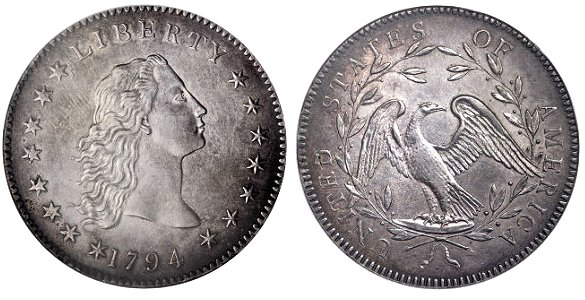
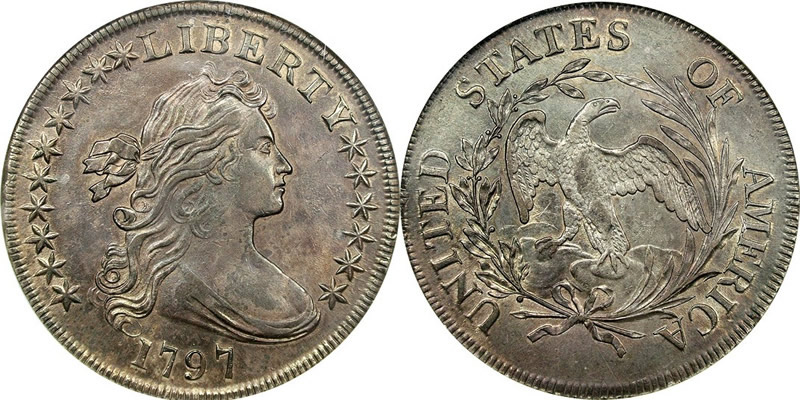
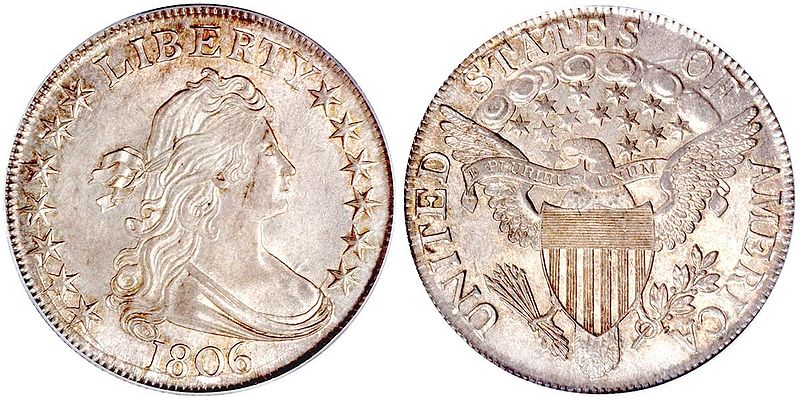
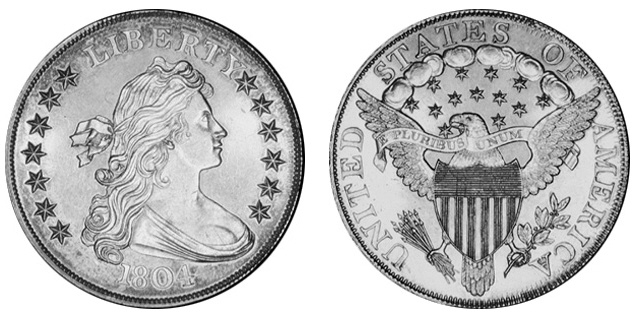
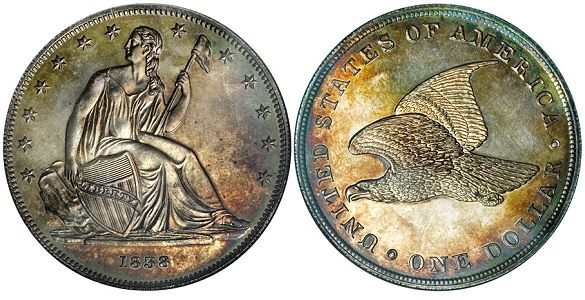
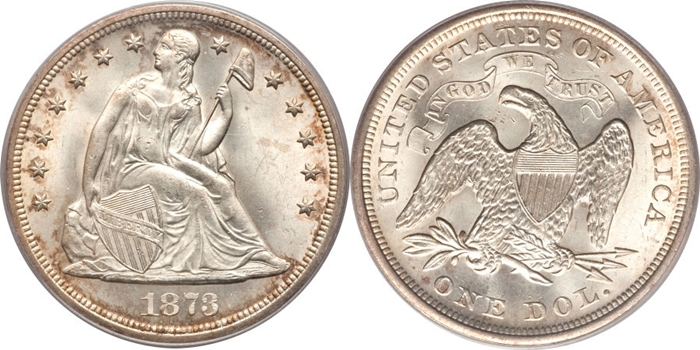
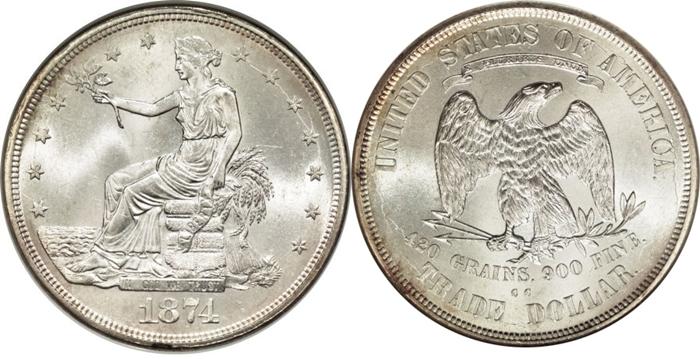
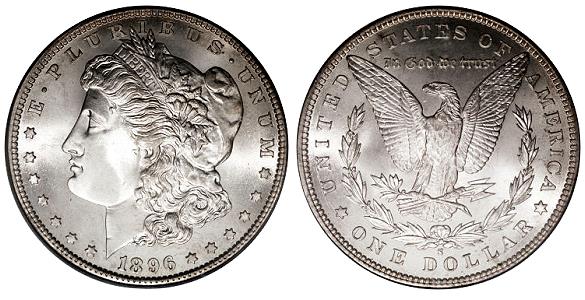
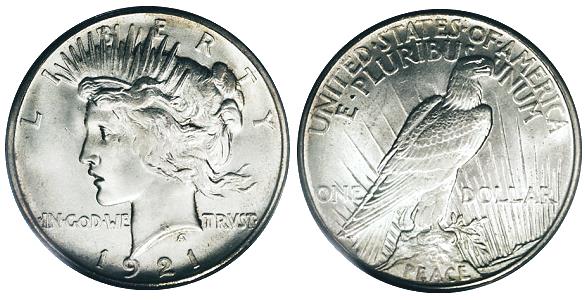
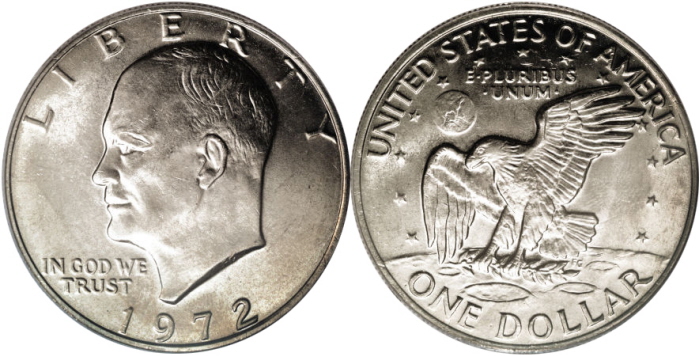

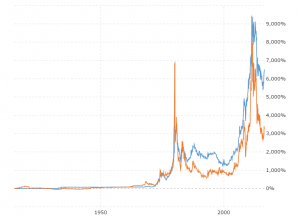

I have an 1878 cc Morgan in I guess fair shape, but stamped across the face in my great great grandfather’s name. Is this coin still worth anything?
At least one dollar.
The coin is now considered non gradeable and would be considered a keepsake. My suggestion is to keep it and show it to your grandchildren. It’s worth more to hold in your hand an item owned by an ancestor. Oh, if coins could only talk.
I have a 1923 silver dollar what is it worth
No.
Would like to have my 1922 coin checked to know it’s value
You haven’t described the coin other than the year. Did you ever wonder how many 1922 coins there are in the world?
You would need to send it to NGC or PCGS and have it graded to determine it’s grade and value.
I am by no means any sort of coin specialist. Have a fair amount of the 1921 peace dollars. It say 18 to $100000 worth. What are the determining factors to be the high end of course. Your help with this is deeply appreciated.
Larry
I have an 1831 Morgan silver dollar in fair condition can anyone tell me what it is worth?
Thanks
I have an 1880 silver dollar which is encased in a silver rim and attached to a silver chain. It was given to my mom as a gift years ago and I would love to know the value, if any. The coin has no marks, holes or punctures but simply sits in the middle.
Thank you, Lisa
I have an 1896 Morgan coin. It’s that valuable or not? Please if valuable so how much and where i could sell..
Regards
My son has a misdated 925 silver liberty dollar. How much is it worth?
He does
He doesn’t have a misstated 925 silver liberty dollars
My error.
My son has a misstated 923 silver liberty dollar. How much is it worth? He doesn’t have a misstated 925 silver dollar.
I have an 1885 silver dollar, can you help me sell it
How. Much is my 1835 silver dollar worth? It has an eagle with spread wings on one side and I think it a Susan Anthony bust on the other
Do you buy silver coins at market value?
I have a 1834 silver dollar in a frame for a necklace. would like to know value.
thanks
I have a 1923 Peace silver dollar. would like to know value.
thanks.
I have 3 1972 Silver Dollars. How much are they worth.
Thank you
I have an 1896 silver dollar and 1923 and 1921 all in excellent condition would like to know how much they are worth
I have an 1896 Morgan silver dollar with the m in the neck and I have two peace 1921and 1923 all in excellent condition would like to know how much they are worth
I a 1926 peace dollar wonder what’s it worth
I have a few sliver dollars. 1996 unc 1888 unc 1896 unc just to name a few. Just wondering what they are worth.
I have 7 Morgan silver dollars with dates from 1878.1883,1885,1897,(2)1921,1922,some are marked EX Fine. I would like to get a value for them.
I want to fine out how much is one oz silver dollar1987 worth today?
I have a Peace 1923 silver dollar, I would like to know the value of it.
I have silver dollars from 1878 to 1922 all in good condition could you please help me with what they could be worth ? And where I could take them to,I live in North Georgia ,I have 12 of them ! Thanks in advance, Vivian Lee
I have 1796 draped bust dollar…in mint state..how much is it… Would you help me?
I would like to no just how much my coins are worth.
1921 Morgan Dollar, 1884 Morgan Dollar, 1922 Peace Dollar,1776-1976 Eisenhower Dollar and a 1971 Eisenhower Dollar
Hello…can’t find a place to ask a question. Looking to purchase mint sewn memorial penny bags. 5000 count! Any suggestions?
Thanks, Rick
I have a 1901CC and a 1903CC Morgan dollars and can’t find the value of either. Both in very fine condition.